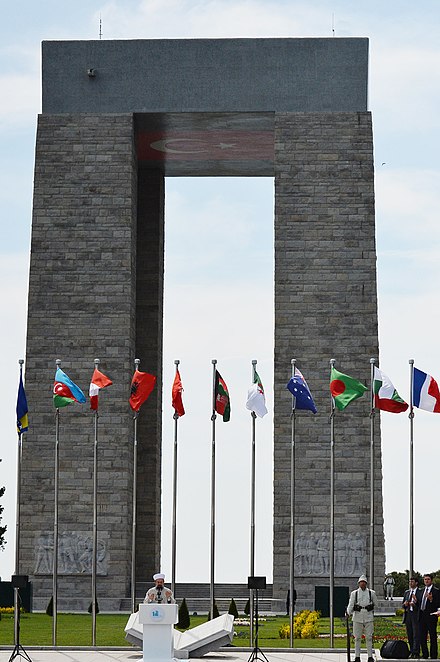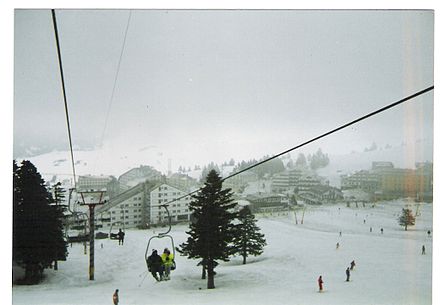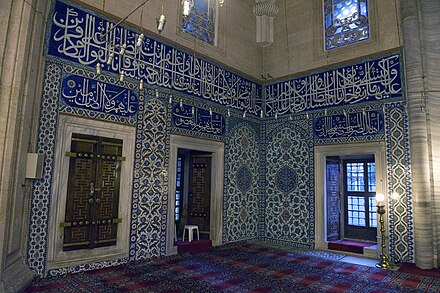Marmara (region) - region of Turkey
Marmara Region in northwest Turkey spans between Europe and Asia, with Istanbul the country's largest city at its heart. It's purely a geographical unit - Turkey doesn't have administrative layers between national government and its 80-some city-provinces - and in 2022 had a population of 27,050,405, a third of the national total.
Regions
Istanbul 📍, capital of three empires, is the grand metropolis connecting Europe and Asia. It's the country's main point of arrival.
This is the European part of Turkey west of Istanbul. Tekirdağ is industrial but has a beach strip.
Edirne near the Bulgarian border is a former Ottoman capital with lots to see.
Gelibolu 📍 gives its name to the Gallipoli peninsula; the 1915 ANZAC landings were near the tip at Eceabat.
Gökçeada is a mountainous island with semi-abandoned Greek villages.
Istanbul's industrial sprawl goes all the way out to Izmit.
Iznik was ancient Nicaea, scene of the first and seventh ecumenical councils of Christianity.
Yalova is a workaday ferry port set among verdant mountains with thermal springs and waterfalls.
Çanakkale on the banks of the Dardanelles is the base for visiting ancient Troy.
Bozcaada is a pleasant breezy island, where in legend the Greek fleet hid before the final assault on Troy.
Marmara Islands in Turkey's inland sea range from cramped resorts to remote getaways.
Balıkesir is basically just a transport hub.
Bursa is the highlight, a former Ottoman capital with lots of early imperial history, and with the nearby national park and winter sports resort of Mount Uludağ.
Understand
_View_of_Old_Mosque_from_15th_century_at_sunset_time.jpg/440px-Turkey_(Edirne)_View_of_Old_Mosque_from_15th_century_at_sunset_time.jpg) A great flooded fault line sunders Europe from Asia. The west channel at Gallipoli / Çanakkale is the Dardanelles (classically known as the Hellespont), the north channel through Istanbul is the Bosporus, and between lies the inland Sea of Marmara. Together they connect the Black Sea with the Med, and if you control the channel you get to control a whole lot else. Tremors along this and related fault lines threw up mountains and hurled down cities. Its geothermal heat seared the limestone bedrock into marble - in Greek μάρμαρον (marmaron) - energetically quarried and shaped into noble buildings and statues, and so the Sea and Region of Marmara were named.
A great flooded fault line sunders Europe from Asia. The west channel at Gallipoli / Çanakkale is the Dardanelles (classically known as the Hellespont), the north channel through Istanbul is the Bosporus, and between lies the inland Sea of Marmara. Together they connect the Black Sea with the Med, and if you control the channel you get to control a whole lot else. Tremors along this and related fault lines threw up mountains and hurled down cities. Its geothermal heat seared the limestone bedrock into marble - in Greek μάρμαρον (marmaron) - energetically quarried and shaped into noble buildings and statues, and so the Sea and Region of Marmara were named.
This region has been the birthplace of empires and their graveyard. Best known are the Ottomans, who emerged in Söğüt around 1300, moved on to capture Bursa then Edirne then Constantinople / Byzantium, nowadays Istanbul, and dominated the East Med region for 600 years. Their cultural descendants could be dubbed the auto-mans, as beyond city centre is a 100+ km industrial sprawl where everyone is either snarled in traffic, driving furiously, or busy manufacturing more automobiles. You need to get past this to enjoy quiet forests such as Çilingoz Nature Park on the European Black Sea coast, the many beaches, and intriguing old towns where you may be the only tourist. Motorways snake across the terrain and you can drive off from Istanbul airport to reach Gallipoli and Troy in a few hours.
Climate is mostly mild and temperate, with warm summers and chilly winters, with much variation by altitude and distance from the sea. Hence Marmara Region has both beach resorts and ski resorts. Western visitors are generally familiar with the Mediterranean summer and regard copious draughts of beer as the antidote. They may be taken aback and unprepared for the winter, with brutal "Lodos" winds and snowfall disrupting even major highways. But to be fair, the local highway maintenance crews seem equally unprepared.
Talk
Istanbul has many English-speakers at least in its tourist sector, but elsewhere they may be hard to find. Learn some basic survival Turkish or have a translation app on your phone - preferably both.
Get in

By air
Istanbul Airport (IATA: IST), in Arnavutköy 40 km northwest of city centre, has excellent international and domestic flight connections, and is Turkey's main port of entry. The city's former main airport "Atatürk" closed in 2019.
The other international airport in Marmara is Sabiha Gökçen (IATA: SAW) in Asia-side Istanbul, much used by low-cost airlines.
There are regional airports with domestic flights at Çorlu (IATA: TEQ), Bursa (IATA: YEI) and Çanakkale (IATA: CKZ).
By train
A train runs nightly from Sofia in Bulgaria and Bucharest in Romania. The portions combine at the border then run via Edirne to Istanbul. In summer a car train runs from Villach in Austria to Edirne.
High speed YHT trains run to Istanbul from Ankara and Konya via Eskişehir. Buses to Bursa connect with the trains at Eskişehir. For destinations in the east of Turkey, change in Ankara.
By bus
International bus routes withered during covid and have not fully resumed, but in 2023 there are daily buses from Bucharest and Sofia to Istanbul. From Greece travel via Sofia.
Most towns in Turkey have direct daily buses to Istanbul. Bursa also has good connections as it's on the highway to Izmir.
By road
Motorways and equivalent fast highways (many toll) span the region, from Edirne near the western border across Istanbul towards Ankara, southwest down the Gallipoli peninsula to Çanakkale, and south past Bursa towards Izmir.
Ferries no longer sail here from Greece or the Black Sea ports.
Get around

Buses from Istanbul serve all the main towns, so any journey along a radial route is straightforward. For cross-country routes you'll do better with your own vehicle: small villages may be linked only by occasional dolmuş, and it's difficult to find reliable timetables for these, even if they bother with one.
There are no air routes within this region, and the only link on the YHT line is Istanbul to Arifiye, for Adapazarı. That leaves railway users to take the regional trains. These trundle infrequently from Istanbul to Edirne, Çorlu, Uzunköprü and Gebze, and from Bandırma and Eskişehir to Balıkesir, continuing to Izmir.
Ferries cross the Sea of Marmara from Istanbul to Bandırma and Mudanya, across its eastern inlet to Yalova, and across the western reaches between Erdek, the Marmara islands, and Tekirdağ. They also link the Princes' Islands just off Istanbul, cross the Dardanelles although there's nowadays a bridge, and sail to the Aegean islands of Bozcaada and Gökçeada. They're a pleasant way to cross the Bosphorus between Europe- and Asia-side Istanbul, though the metro is quicker.
See
- Ottoman capitals: Istanbul was only their third. It has a fabulous collection of architecture, but Bursa and Edirne display the earlier part of the story.
- Bridges and causeways: the Ottomans needed to carry their roads across river valleys that were not deep, but wide and dangerous in spate. They built a series of attractive multi-arched bridges-cum-causeways, some over 1 km long. Many remain in use for light traffic. There are good examples at Dilovası near Gebze, Edirne, Lüleburgaz, and of course at Uzunköprü which means "long bridge".
- Mosques are the main legacy of early Ottoman times, since they've been maintained against earth tremors and land developers. Istanbul and Edirne have the very best.
- Külliyesi is a religious complex centred around a mosque. Typically these contained a madressah (seminary), lodge, soup kitchen, hospital and caravanserai, plus a few tombs. Many have been swept away leaving only the mosque, but Gebze has a surprisingly complete example engulfed in a modern city.
- War Memorials of 1915 for the Allies and the Turks are at the south end of Gallipoli peninsula around Eceabat.
- Decorative tiles adorn many mosques and palaces. The craft was re-launched in the 17th century and is best seen in İznik, though the finest pieces have gone far away.
- Weird attractions include Darıca Hobbit Village in Gebze and Seka Park Film Set in İzmit. Dupnisa Cave near Demirköy has thousands upon thousands of bats, and that's not counting the cave you can't enter because it has too many.
- Istanbul to Izmir is a plexus of long-distance routes across this culturally-rich region.
Do

- Mount Uludağ is a mountain resort linked by cable-car to Bursa, with hiking trails in summer and skiing in winter.
- Beaches and resorts in this region are mostly small, catering to domestic tourism: pleasant examples are along the Gulf of Saros, the Marmara island of Avşa, and the Aegean island of Bozcaada. The international resort strip starts further south beyond Izmir.
- Hot springs bubble up in many areas. The best developed spa zone is in Bursa.
Eat
- Istanbul is the only city with a cosmopolitan choice.
- Other towns offer standard Turkish fare, with limited vegetarian choice. They have neither the polyglot mix of west European cities nor an international tourist market, so they lack other cuisines such as Chinese.
Drink
- Beer, wine and rakı is served in most cafes. There are few free-standing bars outside Istanbul.
- Wine (mostly red) is grown locally, especially in Şarköy District on the Marmara coast, and on the islands of Avşa and Bozcaada.
- Rakı is no longer distilled at Tekirdağ, production has moved to the Izmir area, but there's no shortage.
Stay safe

Beware traffic even on back country lanes, and safeguard valuables.
The seas are not tidal, but may have stiff currents and careless boat-drivers.
Go next
- South is Aegean Turkey, with Izmir the country's third largest city, and top sights including Ephesus, Pergamon and Pamukkale.
- East is Central Anatolia, with the capital Ankara, old-world Konya, and the fairy chimneys of Cappadocia.
- Northeast, Black Sea Turkey takes in grubby Zonguldak, beach resort Samsun and faraway Trabzon.
- West you cross the border, either into Bulgaria or Greece.
Marmara Region
Timezone:MultiplePopulation:23.2 MCoordinates:41.00, 29.00